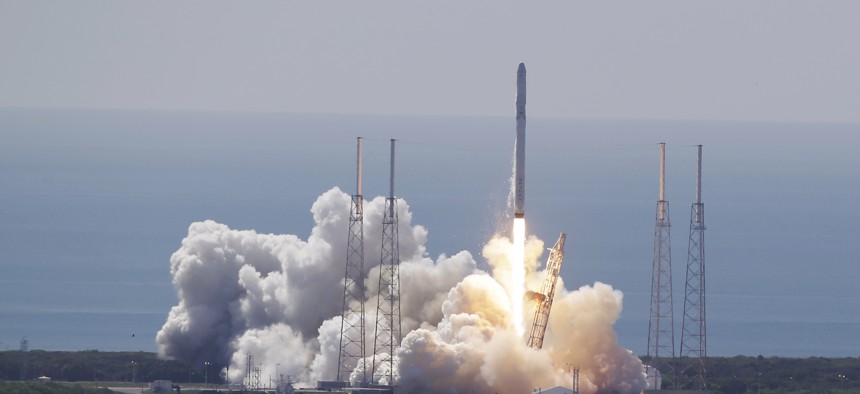
The SpaceX Falcon 9 rocket and Dragon spacecraft lifts off from Space Launch Complex 40 at the Cape Canaveral Air Force Station in Cape Canaveral, Fla., Sunday, June 28, 2015. John Raoux/AP
SpaceX Is Picking Up the Pieces of Their Rocket Business After a Weekend Explosion
The company is combing through thousands of data feeds to figure out what went wrong - and how to protect their core business.
After a SpaceX Falcon 9 rocket came apart on a flight to re-supply the International Space Station, the company’s technical staff is scrambling to review 3,000 different telemetry feeds for information to explain what went wrong.
The actual scale of the loss—beyond the $60 million rocket and four tons of supplies—won’t be clear until the cause of the accident is identified. The Falcon 9 is the company’s work-horse product. Some $7 billion in revenue from 50 scheduled missions depend on it being able to fly.
The next launch is expected in August, when the company is contracted to lift an ocean-studying satellite on behalf of a joint EU-US mission; neither the company nor the partners has commented on whether the mission will go forward. And that’s just the tip of the iceberg: Nearly every major satellite company is counting on SpaceX to put satellites into space within the next year, including Iridium, SES, Eutelsat, and Orbcomm.
The company has attracted such clientele because of its recent record of reliability, low cost, and speed. In the event that SpaceX cannot quickly isolate and repair the fault, the options for clients are limited, given questions about the reliability of the latest generation of Russian Proton rockets and packed flight schedules for SpaceX competitors like Arianespace and United Launch Alliance, the latter a joint venture of Lockheed Martin and Boeing.
SpaceX officials say they are confident the problem did not occur in the first stage of the rocket, and that the Dragon space capsule mounted on top continued to function after the rocket began to disintegrate. And SpaceX president Gwynne Shotwell says that an in-flight abort system currently being developed for a manned version of the capsule would have saved it in the event of a similar crisis.
But whatever went wrong in the second stage of the rocket as it flew some 5,000 kilometers per hour will need to be identified and fixed before it can fly again. The company’s founder and chief rocket designer, Elon Musk, tweeted on the day of the accident that the company was examining an “overpressure event” in a liquid oxygen tank used to fuel the second-stage engine, but no further details have emerged.
Beyond assessing the flight data and any debris that can be recovered, teams are assembling to review every aspect of the vehicle’s construction and delivery to the launch site. SpaceX officials say they are hopeful their largely in-house manufacturing process will allow them to surface the problem quickly.


